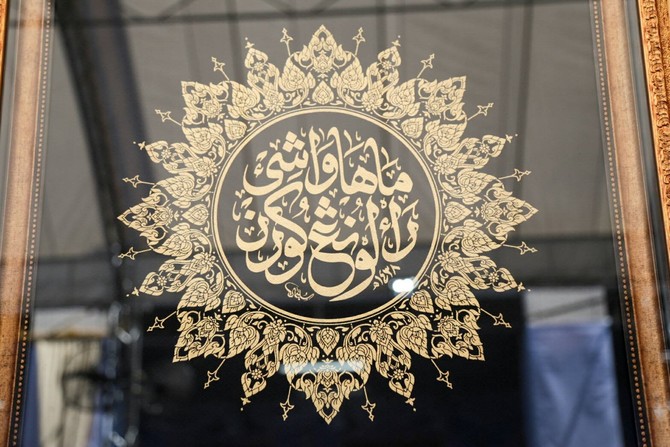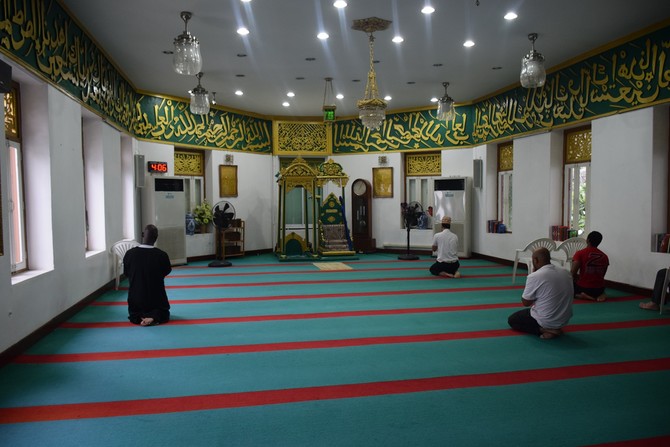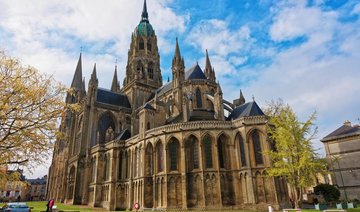BANGKOK: “Only a few years ago there was no such thing as Thai-Islamic art and now a piece of it sits inside the royal palace,” beams Ismail Ywaiyavata, the 39-year-old vice chairman of the Institute of Islamic Art Thailand.
I am sat in a modest-sized room inside the Tuan Suwanasana Chularjmontri Foundation in the Bang Rak district of Bangkok.
All four walls display works of Thai-Islamic art, some lean on tables because of a lack of space. In one corner, a desk with a lamp and open laptop acts as Ywaiyavata’s office. Next to that, on an artist’s drawing board, bamboo quills lie scattered across pieces of calligraphy.
The building is also multi-functional, serving as a community hall and a school.
The Bang Rak district is noted for its upmarket hotels and old European-style architecture, but I am here because it is also where one of Bangkok’s largest concentration of Muslims live and Ywaiyavata, a popular member of this so-called “Muslim Quarter,” is heading up its most exciting new project.
“Thai people don’t know about Islamic art. We want to use it to promote the beauty of Islam. That is why we are developing our own modern interpretation of a Thai-Islamic art style,” he said.
Of medium build, Ywaiyavata’s round face has a typically light beard. He is wearing a round collared, navy blue top with stonewashed denim jeans. A fine art graduate, Ywaiyavata founded the institute in April 2016 alongside local lawyer, Abdul Samad, calligrapher, Ustad Suleiman and Islamic art graduate, Shareef Toleb. Within a few months, they were given the opportunity to seek royal approval.
Last December, they presented the king with a piece of their pioneering work.
“We wanted to show the king how our art style brings the two cultures together. The design we presented took the popular Thai lotus flower and applied the Islamic artistic principles of geometry and repetition to create a frame inside which we wrote his name in Arabic calligraphy.”
The exquisite piece has a circular frame of mesmeric lotus flowers that echo patterns seen all over Thailand, from architecture to clothing. In the middle, the king’s full name, Maha Vajiralongkorn Bodindradebayavarangkun, is artistically inscribed in Arabic calligraphy. Made by placing gold leaf onto the finest black Thai silk, the result is stunning and made quite the impression.
“The king asked me about the patterns and how we came up with the idea. He agreed it was a beautiful way to present Islamic culture in Thailand,” Ywaiyavata said.
However, Ywaiyavata’s institute is not just about calligraphy.
Two of the largest pieces on display are by award-winning female Thai artist, Thidarat Chantachua.
Using colored threading on black canvas, Chantachua’s semi-abstract, geometric patterns present an echo of arabesque architecture.
The institute has also begun work on the first-ever Qur’an to be decorated with the new Thai-Islamic design style.
When we head outside, Ywaiyavata shows me where the institute hopes to soon be permanently based — a pretty house, complete with pale blue wooden slats. Like many buildings in Bang Rak, it is more European than Thai.
Muslims in Bangkok
As we walk down the narrow back streets of the Muslim quarter, we pass doors with “bismillah” written above them. Turning a corner, the air becomes smoky and filled with the whiff of roasting meat. A hijab-wearing Thai woman stands grilling satay sticks on a food cart labelled “halal.”
The woman smiles warmly and returns our greetings. Above her, a green sign announces the Haroon Mosque, one of the oldest in Bangkok.
Mohammed Kanzi, a local postgraduate student of Islamic history and a volunteer at the institute, tells me the story behind the mosque.
“It was named after Haroon Bafadel, whose father was an Indonesian-Arab trader from south Borneo. He built a wooden mosque in the Javanese style on the banks of the Chao Phraya in 1837.”
Bafadel’s father, Musa, arrived long before Bangkok became the huge metropolis it is today. Back then, the mosque stood in a village called Tom Samrong, outside the capital.
“This is why the mosque’s first name was the Tom Samrong Mosque. Then, in 1899, the Thai government wanted the land to build a customs house and the mosque was rebuilt inland.”
The first rebuild was also wooden, but in 1934, a brick building was constructed in the style of the surrounding architecture. As a result, the Haroon Mosque looks more like a European townhouse than an oriental institute, complete with neo-classical floral motifs, mock romanesque pillars and wooden shutters.
“The only distinguishing Islamic feature was that crescent and star mold up there,” my guide said as he pointed toward the ceiling.
Ywaiyavata and I strain to see where our guide is pointing — high up on the apex roof’s brickwork, a gold-and-green crescent and star can just about be made out.
Origins of Thai-Islamic art
Once inside, the real reason I was brought here becomes apparent. At the front of the prayer hall, two ornate wooden structures stand in stark contrast to the mosque’s otherwise simple, plain interior.
“This unique mehrab and mimbar might also be called Islamic-Thai art style. The mehrab reminds us of the royal barges on our rivers and has Arabic and French influence. Meanwhile, the mimbar is a cross between a Muslim and traditional Thai throne,” Mohammed said.
The Muslim Quarter
The Haroon Mosque is one of many in Bang Rak. There is also the Ban Oou Mosque, Faizane Madina and the brilliantly-named Thai-Pakistan Friendship Mosque.
Thailand’s capital is home to the largest concentration of Muslims in the country and Bang Rak’s community wonderful reflects this diversity. Mohammed explained how many reached the shores of Thailand.
“We know Muslim traders were in contact with Thailand since the early times of Islam and this led to conversions and inter-marriage along the Malay peninsula, so many Muslims here have Malay and Middle Eastern ancestry. Others are Thai whose families converted sometime in history and then there are those from the Indian Sub-Continent that came here as sea merchants centuries ago.”
Mohammed’s own ethnic ancestry is Malay and Chinese, while Ywaiyavata traces his paternal roots to southern Thailand and his maternal roots back to Hadhramaut in Yemen.
The ethnic diversity is also reflected in the halal eateries of Bang Rak. Places serving Indian, Pakistani and Middle Eastern food rub shoulders with halal Thai eateries and Muslim grocery stores are more abundant here than in most other parts of Bangkok.
In a city famous for its hedonism, Bang Rak presents a refreshing haven for Muslim travelers headed to Thailand’s capital city.
Exploring Bangkok’s ‘Muslim Quarter’
Exploring Bangkok’s ‘Muslim Quarter’

Venice expands its day-tripper tax program in bid to combat overtourism

- A UNESCO body decided against putting Venice on its list of cultural heritage sites deemed in danger after the tax was announced
- Opponents of the day-tripper fee say it has done nothing to discourage tourists from visiting Venice even on high-traffic days
VENICE, Italy: Venice is charging day-trippers to the famed canal city an arrivals tax for the second year starting Friday, a measure aimed at combating the kind of overtourism that put the city’s UNESCO World Cultural Heritage status at risk.
A UNESCO body decided against putting Venice on its list of cultural heritage sites deemed in danger after the tax was announced. But opponents of the day-tripper fee say it has done nothing to discourage tourists from visiting Venice even on high-traffic days.
Here’s a look at Venice’s battle with overtourism by the numbers:
5-10 euros (about $6-$11)
The fee charged to visitors who are not overnighting in Venice to enter its historic center during the second year of the day-tripper tax. Visitors who download a QR code at least three days in advance will pay 5 euros ($5.69) — the same amount charged last year throughout the pilot program. But those who make last-minute plans pay double. The QR code is required from 8:30 a.m. until 4 p.m. and is checked at entry points to the city, including the Santa Lucia train station, the Piazzale Roma bus depot and the Tronchetto parking garage.
54
The number of days this year that day visitors to Venice will be charged a fee to enter the historic center. They include mostly weekends and holidays from April 18 to July 27. That is up from 29 last year. The new calendar covers entire weeks over key holidays and extends the weekend period to include Fridays.
2.4 million euros
That is the amount Venice took in during a 2024 pilot program for the tax. The city’s top budget official, Michele Zuin, said last year the running costs for the new system ran to 2.7 million euros, overshooting the total fees collected. This year, Zuin projects a surplus of about 1 million euros to 1.5 million euros, which will be used to offset the cost of trash collection and other services for residents.
450,000
The number of day-trippers who paid the tax in 2024. Officials say 8,000 day-trippers paid in advance to enter the city on Friday, among the 77,000 who have already registered so far to enter the city this year. Another 117,000 have registered for exemptions, which apply to anyone born in Venice, those paying property taxes in the city, studying or working in the historic center, or living in the wider Veneto region, among others.
75,000
The average number of daily visitors on the first 11 days of 2024 that Venice charged day-trippers. That’s about 10,000 people more than the number of tourists recorded on each of the three important holidays during the previous year. City council member Giovanni Andrea Martini, an opponent of the measure, said the figures show the project has not deterred visitors.
48,283
The number of official residents in Venice’s historic center composed of over 100 islands connected by footbridges and traversed by its famed canals. The population peaked at 174,000 in 1951, when Venice was home to thriving industries. The number shrank during Italy’s postwar economic boom as residents moved to the mainland for more modern housing — including indoor plumbing which was lacking in Venice. It has been shrinking dramatically over recent decades as local industry lost traction, families sought mainland conveniences and housing prices rose. Activists also blame the “mono-culture” of tourism, which they say has emptied the city of basic services like shops for everyday goods and medical care.
51,129
The number of beds for tourists in Venice’s historic center, including 12,627 in the less regulated short-term rental market, according to April data from the Ocio housing activist group. The number of tourist beds surpassed the number of permanent residents in 2023, according to Ocio’s monitor. Anyone staying in a hotel within the city limits, including on the mainland districts of Mestre and Marghera, pays a lodging tax and is therefore exempt from the day-tripper tax.
25 to 30 million
The number of annual arrivals of both day-trippers and overnight guests roughly confirmed by cellphone data tracked from a Smart Control Room since 2020, according to city officials.
Saudi traditional crafts on show at Jouf camel auction

- Women demonstrate art of making sameel storage pouches
RIYADH: The art of making leather containers for storing food and drinks was just one of the attractions at the recent Jouf camel auction in Dumat Al-Jandal governorate.
With 2025 designated as the Year of Handicrafts, festivals across Saudi Arabia are providing important platforms for artisans to showcase and market their traditional skills.
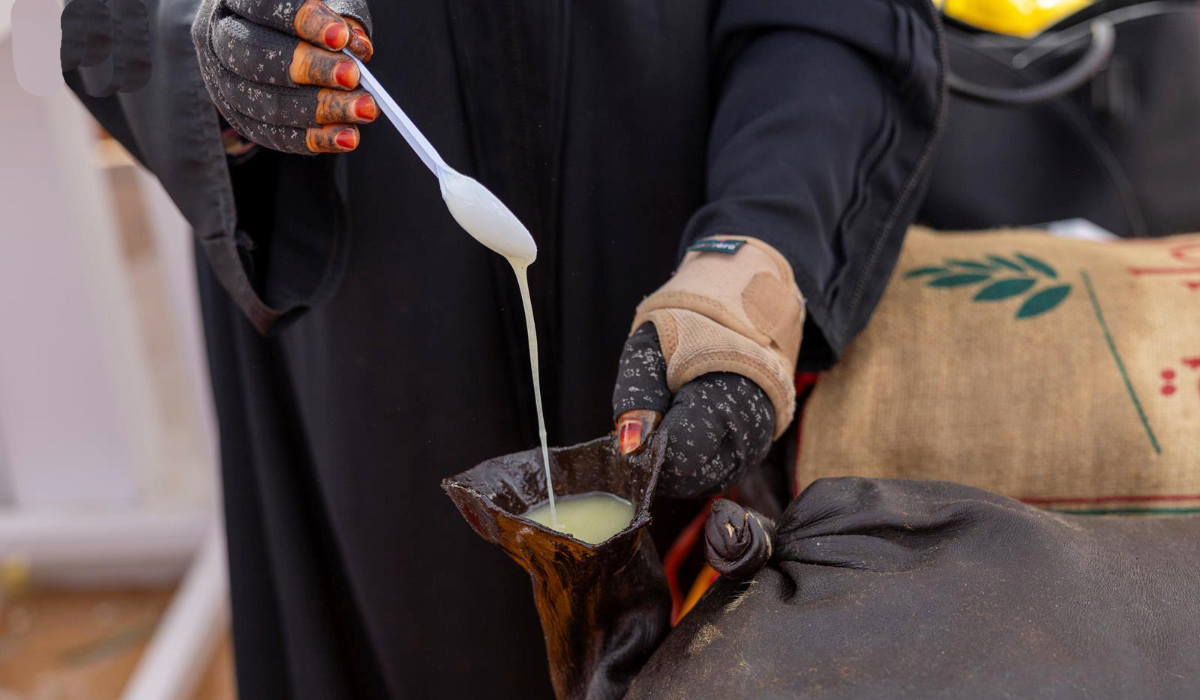
At the camel auction, which ends on Tuesday, craftswoman Umm Meshaal, told the Saudi Press Agency how she produced sameel, a type of pouch made from animal hide and used for storing ghee, yogurt and water.
Meshaal said that sheep skin worked best for keeping yogurt, while goat skin was better for ghee.
FASTFACTS
• At the Jouf camel auction, craftswoman Umm Meshaal told the Saudi Press Agency how she produced sameel.
• It is a traditional pouch made from animal hide and used for storing ghee, yogurt and water.
The process starts by tanning the skins using a tree extract and salt to remove the hair and any impurities. The hides are then left to dry before being cut and sewn together into the desired shape.
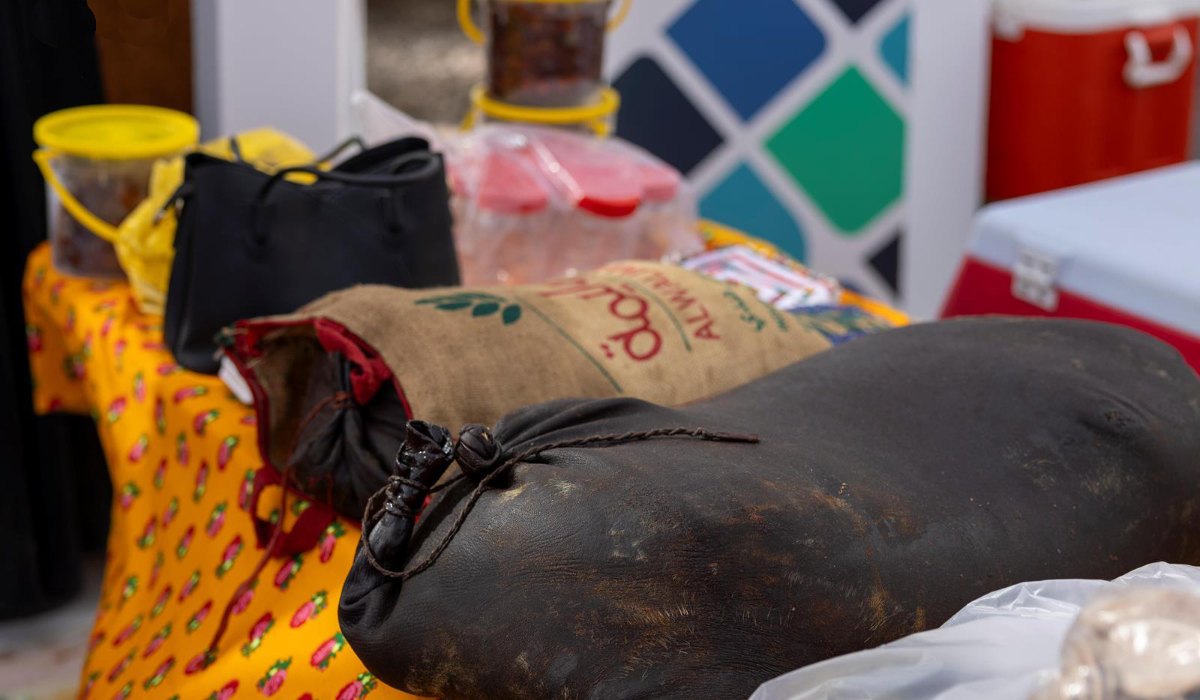
The ancient art of making sameel is still relevant in modern-day Jouf, particularly among Bedouin communities who use them for storing and carrying vital supplies.
Many consumers say the best ghee in the Kingdom comes from these traditional vessels, the report said.
A look at NEOM’s prehistoric masterpieces etched in stone

- Open-air museum of ancient artworks is key to decoding past civilizations
- Drawings reveal how human beings interacted with now-extinct animals in the area
MAKKAH: In the heart of NEOM’s Hisma Desert, where sandstone mountains and plateaus rise from the arid landscape, is an extraordinary collection of ancient rock art and archaeological inscriptions. These priceless treasures illuminate the cultural and economic vitality of long-lost civilizations.
Once a vital corridor for caravans travelling the ancient trade routes of the Arabian Peninsula, this region preserves an invaluable legacy etched into its geological formations.
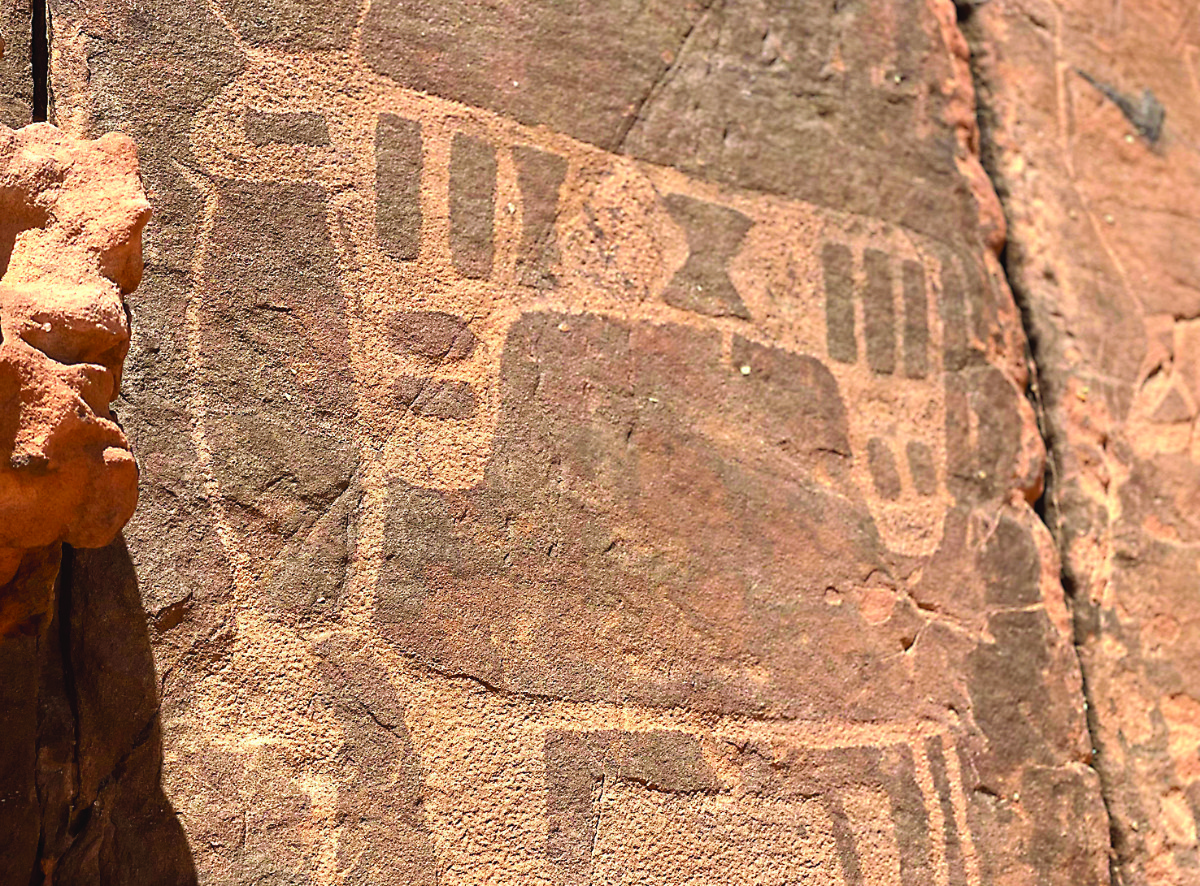
Abdulelah Al-Fares, a photographer and expert in ancient artifacts and a member of the Saudi Heritage Preservation Society, told Arab News that the rock art is in the mountains and plateaus in NEOM, part of a mountain range in the northwestern part of Tabuk.
Hisma Desert is bordered by the Sharah Mountains to the north, by Wadi Araba to the northwest, by the Hijaz Mountains to the west, and by Harrat Al-Raha to the south.
HIGHLIGHTS
• Studying rock art in the region matters deeply because it reveals economic and cultural changes that shaped the northern Arabian Peninsula.
• The drawings show how people interacted with now-extinct animals in the area, as well as with livestock and camels.
• Among the standout examples are life-sized camels crafted with remarkable precision and aesthetic detail.
“The plateaus, part of the Hisma Desert and its geological formations, represent an open-air museum of nature, ancient rock art, and diverse historical inscriptions,” he said.
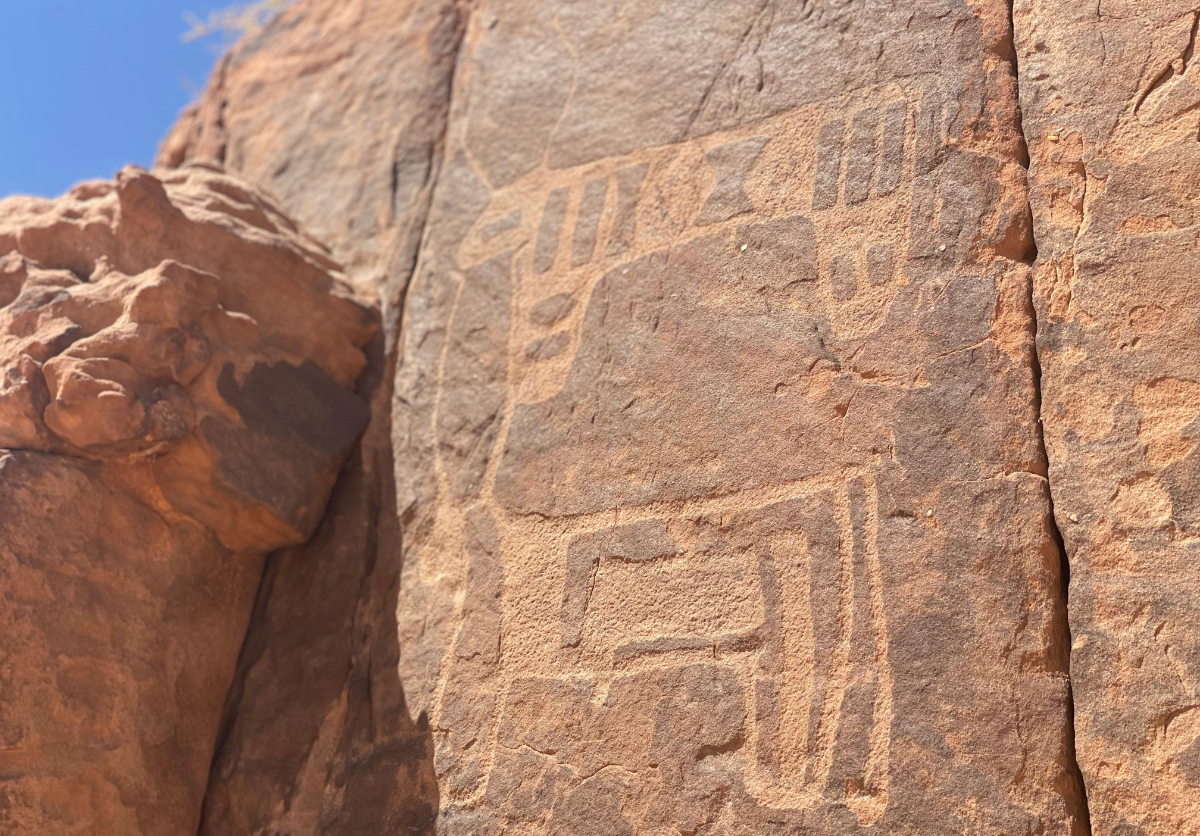
The rock drawings feature engravings of human figures, animals and various scattered scenes throughout the site.
The engravings on the plateau’s facades depict scenes of animals, including wild animals such as camels, cattle, ibexes, ostriches and wolves, as well as other predatory animals, and depictions of hunting scenes and human combat.
These drawings are notable for their precision and have remarkably withstood the elements for thousands of years.
Abdulelah Al-Fares, Saudi Heritage Preservation Society member
“These drawings are notable for their precision and have remarkably withstood the elements for thousands of years,” he said. “Most of the themes and scenes in some of the rock drawings in the region are repeated and depict, to some extent, the world of wild animals and the interactions of humans through hunting and warfare.
“The mountains embody a civilizational and cultural legacy through their distinctive rock drawings featuring human and animal forms,” Al-Fares said.

He also highlighted the value of exploring NEOM’s ancient rock art. These carvings — depicting animals, hunting scenes and human figures — are a bridge between our modern lives and the world of humans thousands of years ago. They are a source of cultural and historical knowledge.
The artworks also illuminate the journey of human civilization, revealing its cultural and social evolution in the region.
Scattered throughout the area, a wide array of rock art sites show a vast and dense collection of drawings and archaeological inscriptions from different eras etched on mountain surfaces.
Al-Fares pointed out their diversity, noting the varied artistic styles, forms, and themes that distinguish each piece.
Among the standout examples are life-sized camels crafted with remarkable precision and aesthetic detail. The careful attention to detail is thought to underscore the camel’s role as an essential sources of food and transport in ancient times.
Another façade shows a herd of cows, all facing forward, their large crescent-shaped horns curving at the tips. Encircling this herd, human figures of varying sizes are skilfully carved.
These ancient artworks are pictorial panels of human history, activity, environmental adaptation, and cultural development during ancient times. Their value shines brighter given the scarcity of insights into prehistoric life.
Studying rock art in the region matters deeply because it reveals economic and cultural changes that shaped the northern Arabian Peninsula.
The drawings show how people interacted with now-extinct animals in the area, as well as with livestock and camels.
Many carvings portray human beings astride animals, including a warrior wielding a spear and sword, rendered with finesse and skill.
Scattered throughout the region, some drawings hint at the presence of different ethnic groups that lived in the area. The provide clues to migratiosn and trace the routes of trade caravans that used these locations as settlement points.
Saudi Arabia’s Hail poppy reserve attracts thousands of tourists

- Since opening in 2022, the reserve, which covers 10,000 sq. meters, has drawn thousands of domestic and foreign visitors
HAIL: With its vibrant array of wildflowers framed by golden sand dunes and majestic mountains, the Poppy Reserve in Al-Khattah is one of the Hail region’s most captivating attractions.
Since opening in 2022, the reserve, which covers 10,000 sq. meters, has drawn thousands of domestic and foreign visitors, particularly during holidays, Eid and the spring season.
The attraction enchants guests with its sweeping fields of poppies, perfectly balanced in form and color. As the sun sets, the golden rays cast a warm glow over the landscape and create a natural wonder.
This striking beauty enhances the region’s reputation for breathtaking scenery and offers a unique experience.
Madinah Retreats: Culture, spirituality to power up the soul

- Paradigm shift blends wellness practices, cultural expeditions, spiritual experiences
JEDDAH: In the sacred embrace of Madinah, one of Islam’s holiest sites, a new culture-oriented wellness experience is offering a journey that integrates spirituality, culture, and heritage.
The inspiration behind Madinah Retreats stems from founder Moatassem Al-Bitar’s experience in the wellness and spiritual tourism industry in Saudi Arabia and beyond.
Recognizing key gaps in traditional retreat models and leveraging Saudi Arabia’s tourism vision, he envisioned a paradigm shift that blends modern wellness practices, cultural expeditions, and spiritual experiences into a single journey.

With a background as a corporate culture change and people engagement manager, Al-Bitar has curated over 50 retreats across Saudi Arabia, Egypt, and the US, serving more than 400 participants.
His academic training spans diverse fields, including organizational behavior, Islamic spirituality, and intercultural studies.
Officially launched in 2024 after five years in the making, the initiative held its second retreat, under the theme “The Arrival,” earlier this year in Madinah.
FASTFACTS
• Madinah Retreats stems from founder Moatassem Al-Bitar’s experience in the wellness and spiritual tourism industry in Saudi Arabia and beyond.
• It blends modern wellness practices, cultural expeditions, and spiritual experiences into a single journey.
Al-Bitar told Arab News: “Every retreat we design starts with clear intentions and objectives, supplemented by a story and a theme that aligns with a particular destination.”
The retreats feature a collective of facilitators who work together toward a unified intention, ensuring a balanced and immersive experience.
“One of our main goals is to promote different destinations in Saudi Arabia that are perfectly ideal for wellness-centric experiences, in addition to its unmatched culturally enriching character,” Al-Bitar said.
“We seek to partner with pertinent governmental initiatives and entities that fulfill the Kingdom’s Vision 2030 for wellness tourism and exceptional experiences.”
Al-Bitar explained that each retreat is meticulously structured around three core pillars: spirituality (meditative practices and inner reflection); culture (heritage site visits, traditional storytelling, and local experiences); and wellness (movement–based practices, mindfulness exercises, and healing foods).
By integrating these elements into daily programs, Madinah Retreats offers a journey tailored to the needs of participants and is a “philosophy of being rooted, real, and rich.”
The retreats target individuals and groups seeking genuine transformation in their well-being, spiritual connection, and cultural enrichment. They provide a safe and accepting space where participants are respected on their unique paths to healing.
Madinah, which is the spiritual capital of Islam, is popularly known as the Illuminated City. It offers an atmosphere of peace and rejuvenation, and its diverse topography and climate make it ideal for nature-based healing.
“Madinah is widely recognized as a destination where the heart feels at peace, the body feels rejuvenated, the mind feels clarity and the soul feels enriched,” said Al-Bitar. “The city’s rapid development and recognition as a top global tourism destination further enhance its appeal.”
The Madinah Retreats experience is usually hosted in a traditional farm resort surrounded by nature. Participants visit cultural and historic sites, explore the city’s vibrant social scene, and experience local cuisine, contemporary art, and community traditions.
“During the retreat we offer meditation, breathwork, self-reflection, yoga, tai chi, and other somatic therapies, creative expression as a healing tool, as well as locally sourced, nourishing meals,” Al-Bitar added.
The somatic practices guided by expert facilitators enhance body awareness and overall well-being.
Al-Bitar said: “Connecting with nature and animals has proven therapeutic benefits. Madinah Retreats incorporates nature-based and equine therapy to help participants reconnect with their original disposition, providing an irreplaceable form of healing.”
Cultural storytelling is also an essential component, allowing participants to explore the hidden wisdom of each landmark and understand local traditions and historic practices.
No prior experience in meditation or wellness practices is required, making the retreats accessible to all.
Honoring his Egyptian roots, Al-Bitar is expanding the retreats to Siwa, Egypt.
Siwa Oasis, nestled within a breathtaking desert landscape, is characterized by vast dunes, striking limestone outcrops, and distinctive geomorphological features that enhance its appeal as a tourist destination.
“The expansion to Siwa, Egypt, was inspired by the oasis’ 160-year-old tradition of reconciliation — Eid El-Solh, a celebration of harmony,” Al-Bitar said.
“Siwa’s natural healing elements, such as salt lakes, hot springs, and lush landscapes, mirror many of Madinah’s restorative qualities.”
Al-Bitar said that Madinah Retreats will also explore the Kingdom’s hidden gems by hosting retreats in Abha, Aseer, Al-Ahsa, and other locations rich in healing nature and cultural heritage.
Retreat prices range from SR5,000 ($1,333) to SR10,000, depending on the location, program, facilitators, transportation, and accommodation.
Madinah Retreats follows a collaborative model, partnering with local service providers, facilitators, and experts to provide an experience that remains true to the cultural essence of each destination.
Al-Bitar said: “Our content caters to people from different backgrounds, both English and Arabic speakers. Our agenda is characterized by being spacious and offers ample time for self-guided practices. Our way of delivery is strictly non-intrusive.”
Participants leave Madinah Retreats feeling “transformed, enriched, and connected to their most authentic selves.”
Al-Bitar said that the experience embodied the profound wisdom: “You presume you are a small entity, but within you is enfolded the entire universe.”
Madinah Retreats also provides a customized retreat model that caters to corporations and teams, as well as add-on visits such as expeditions in AlUla.



